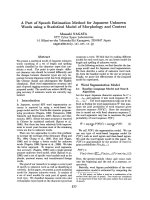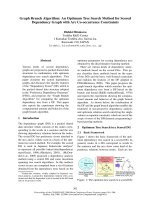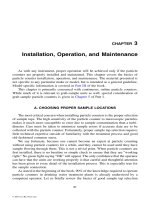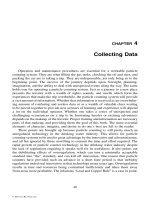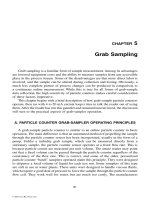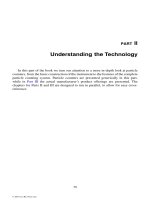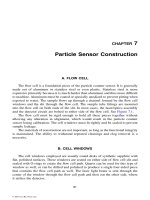A two phase consistent particle method for wave impact problems with entrapped air pockets
Bạn đang xem bản rút gọn của tài liệu. Xem và tải ngay bản đầy đủ của tài liệu tại đây (19.3 MB, 220 trang )
A TWO-PHASE CONSISTENT PARTICLE METHOD FOR
WAVE IMPACT PROBLEMS WITH ENTRAPPED AIR
POCKETS
LUO MIN
NATIONAL UNIVERSITY OF SINGAPORE
2015
A TWO-PHASE CONSISTENT PARTICLE METHOD FOR
WAVE IMPACT PROBLEMS WITH ENTRAPPED AIR
POCKETS
LUO MIN
(B.ENG, HARBIN INSTITUTE OF TECHNOLOGY, CHINA)
A THESIS SUBMITTED
FOR THE DEGREE OF DOCTOR OF PHILOSOPHY
DEPARTMENT OF CIVIL AND ENVIRONMENTAL ENGINEERING
NATIONAL UNIVERSITY OF SINGAPORE
2015
DECLARATION
I hereby declare that this thesis is my original work and it has been written by me in its
entirety.
I have duly acknowledged all the sources of information which have been used in the
thesis.
This thesis has also not been submitted for any degree in any university previously.
Ph.D. Candidate: Luo Min
Signature:
Date:
I
Acknowledgement
I am happy to take this opportunity to express my gratitude to my advisor, Professor
Koh Chan Ghee for his invaluable guidance, support and encouragement throughout my
study at NUS. His critical attitude and rigorous scholarship in research has a great
influence on me. And I think this influence will accompany me in the study and work of
the rest of my life.
Great thanks are also expressed to my co-supervisor Professor Bai Wei. I am really
appreciative of his kindness to arrange a meeting with me whenever I need a discussion
on my research. From these heuristic discussions, I have learned how to analyze a new
problem and then think a way out to solve it.
Professor Lin Pengzhi in Sichuan University and Professor Shao Songdong in the
University of Sheffield are acknowledged for the useful discussions and valuable
comments from them. In addition, the instructive comments and suggestions from
Professors Khoo Boo Cheong and Vivien Chua in NUS are also appreciated.
Heartfelt gratitude is sent to Dr. Gao Mimi, who guided me to learn the in-home
developed numerical algorithm and do laboratory experiments. Without her patience and
help, I could not have finished my Ph.D. study in the tight time frame.
I would like to thank the staff in the Structural and Concrete Laboratory, especially
Mr. Koh Yian Kheng, Mr. Ang Beng Oon and Mr. Ow Weng Moon. Without their help
and assistance, I could not have finished my experimental study successfully.
I also would like to thank my friends: Dr. Zhang Zhen, Dr. Zhang Jian, Dr. Zhang
Mingqiang, Dr. Zhang Yi, Dr. Gao Ruiping, Ms. Han Qinger, Ms. Zhang Shanli, Ms.
II
Zhang Hong, Mr. Sun Gang, Mr. Gao Qingfei, Mr. Wang Yu, Dr. Yu Chao and Mr.
Zhang Xiaodong, and all the other friends who have helped me. It was the discussions
with them that inspired my study and research. And it was the recreational time spent
with them that made my Ph.D. journey relaxed and colorful.
Last but not least, I wish to express my love to my family: my parents, grandparent,
younger sister and my girlfriend. Thanks for their understanding, encouragement and
love. Without their supports, the completion of my thesis would not have been possible.
III
Summary
In many circumstances, violent fluid motions such as wave impacts on
coastal/offshore structures generate air entrapment. The entrapped air may affect the
amplitude and duration of impact pressure because of the air cushion effect. Numerical
treatment of this problem remains a challenge because of its complexity, and most of the
research findings were obtained from experiments. In this context, the main objective of
this thesis is to develop a new numerical method that can simulate violent wave impact
processes with entrapped air pocket so as to achieve further insight into wave-impact
processes and better prediction of impact pressures.
Most of the numerical methods developed for fluid dynamics problems can be
classified into the mesh-based and meshless methods. Among these methods, a
Lagrangian meshless method (also called particle method) is adopted in this study
because it is, in principle, capable of modelling large deformation, tracking fluid
interface and avoiding the numerical diffusion induced by the discretization of the
convection term of the Navier-Stokes Equations. Among existing particle methods, the
recently developed Consistent Particle Method (CPM) that computes the spatial
derivatives in a way consistent with Taylor series expansion and eliminates the use of
kernel function is selected because of its promising features to generate smooth fluid
pressure without the use of artificial parameters such as the artificial viscosity.
The main challenges in modeling wave impact with entrapped air pocket include (a)
approximations of gradient and Laplacian operators involving large density difference
(three orders of magnitude for water-air flows) and (b) integrated modelling of
incompressible water and compressible air. To resolve the first issue, a new scheme is
IV
proposed by dealing with the pressure gradient normalized by density. Based on the
generalized finite difference scheme, this approach uses all the neighbor particles
(including those of another fluid) in the influence domain of a reference particle to
compute the spatial derivatives with abrupt density discontinuity. In addition, an adaptive
particle selection scheme is proposed to overcome the problem of ill-conditioned
coefficient matrix of pressure Poisson equation when particles are sparse and non-
uniformly spaced. These two improvements lead to the incompressible two-phase CPM
(I-2P-CPM) for incompressible two-phase flows characterized by high density ratio.
To address the second challenge, a compressible solver is developed in the
framework of thermodynamics. In this way sound speed is not explicitly involved and
thus the compressible solver avoids the problem as encountered by some other numerical
methods in the determination of numerical or artificial sound speed. In addition, this
compressible solver can be easily integrated with the I-2P-CPM because they both use
the same predictor-corrector scheme to solve the governing equation of primitive form.
This leads to the two-phase CPM (2P-CPM) that is applicable to incompressible-
compressible two-phase flows with abrupt density discontinuity. The developed
algorithms are validated by numerical examples in comparison with published results in
the literature and the present experimental studies.
To demonstrate the performance of 2P-CPM, a new experiment is designed and
conducted particularly for obtaining an air pocket and measuring its shape and pressure
change under wave impact. In all the cases considered, the numerical results agree well
with the experimental results, including air pressure oscillation due to air cushion effect.
The results show that modelling of compressible air is crucial in wave impact scenarios
with entrapped air pocket.
V
Table of contents
Acknowledgement I
Summary… III
Table of contents V
List of figures IX
List of tables XV
Nomenclature XVII
Chapter 1 Introduction 1
1.1 Overview of the study on wave impact 1
1.2 Mesh-based methods for fluid-mechanics problems 4
1.2.1 Finite Difference Method 5
1.2.2 Finite Volume Method 7
1.2.3 Finite Element Method 7
1.3 Particle methods for fluid-mechanics problems 8
1.3.1 Smoothed Particle Hydrodynamics 9
1.3.2 Moving Particle Semi-implicit method 17
1.3.3 Consistent Particle Method 20
1.4 Studies on incompressible two-phase flows 24
1.5 Studies on incompressible-compressible two-phase flows 27
1.6 Objective and scope 31
1.7 Research significance 32
VI
1.8 Organization of the thesis 34
Chapter 2 CPM for incompressible 2-phase flows with large density difference 41
2.1 Consistent Particle Method 43
2.2 Governing equations for two-phase flow 48
2.3 Numerical algorithms 51
2.3.1 Gradient and Laplace involving density discontinuity 51
2.3.2 Adaptive particle selection scheme 57
2.4 Performance test of the derivative approximation scheme 61
2.5 Validation examples of 2-phase flows 62
2.5.1 Rayleigh-Taylor instability 62
2.5.2 Gravity current flow 63
2.5.3 Water-air sloshing under translational excitation 65
2.5.4 Sloshing in a closed tank under rotational excitation 70
2.5.5 Dam break 72
2.6 Concluding remarks 74
Chapter 3 CPM for 2-phase incompressible and compressible flows 97
3.1 Governing equations 99
3.2 Numerical algorithms 100
3.2.1 Thermodynamic considerations 100
3.2.2 Polytropic gas law 101
3.2.3 Pressure Poisson equation considering fluid compressibility 103
VII
3.3 Performance test of compressible solver 106
3.3.1 Evaluation of air density 106
3.3.2 Compression and expansion of air 108
3.3.3 Pressure wave propagation in an air tube 109
3.4 Validation for two phase flows 112
3.4.1 Water injection into a closed air tube 112
3.4.2 Oscillating Water Column 114
3.4.3 Large Dam break 115
3.5 Concluding remarks 119
Chapter 4 Wave impact with entrapped air pocket: experimental study and 2P-CPM
simulation 133
4.1 Experimental setup 133
4.1.1 Excitations to generate sloshing 134
4.1.2 Water container 134
4.1.3 Pressure sensor 134
4.1.4 Displacement transducer 136
4.1.5 Video camera 136
4.2 Wave impact under translational excitations 136
4.2.1 Case C1: initial air-pocket pressure 1.01325×10
5
Pa 138
4.2.2 Influence of the polytropic index n on numerical results 143
4.2.3 Case C2: initial air-pocket pressure 1.01890×10
5
Pa 144
VIII
4.2.4 Initial air-pocket pressure 1.50×10
5
Pa (C3) and 2.10×10
5
Pa (C4) 145
4.2.5 Parametric study 146
4.3 Wave impact under rotational excitations 147
4.4 Concluding remarks 148
Chapter 5 Conclusions and future work 171
5.1 Conclusions 172
5.2 Future work 175
References. 177
Appendix: Derivation for the polytropic gas law based on thermodynamics and ideal gas
law………. 193
IX
List of figures
Figure 1-1. Concept of gradient model in MPS 39
Figure 1-2. Concept of Laplacian model in MPS 39
Figure 2-1. Density change across the interface of a two fluid system 77
Figure 2-2. Mixing of water and air particles near fluid interface 77
Figure 2-3. Evaluating fluid density from a collection of point masses 78
Figure 2-4. 1D hydrostatic example involving water and air (pressure distribution not to
scale) 78
Figure 2-5. Schematic view of an adaptive particle selection scheme (N is the number of
real neighbor particles) 79
Figure 2-6. Analytical and numerical results of the Laplace of a 2D function 80
Figure 2-7. Global error of Laplacian approximation by CPM, MPS and ISPH 80
Figure 2-8. Snapshots of Rayleigh-Taylor instability problem 81
Figure 2-9. y-coordinate of tips of falling and rising fluids in Rayleigh-Taylor instability
81
Figure 2-10. Geometric dimensions of gravity current example 82
Figure 2-11. Gravity flow: comparison of predicted front positions of heavier fluid by I-
2P-CPM with experimental results by Adduce et al. (2012) 82
Figure 2-12. Snapshot of Run 9 at 11 s (unit: m): (a) Particle position in comparison with
numerical result by Adduce et al. (2012) (black solid line); (b) Particle velocity 83
X
Figure 2-13. Definition of parameters for water-air sloshing under translational excitation
83
Figure 2-14. Sloshing waves in a rectangular tank under translational excitation: ISPH
result, I-2P-CPM result and experimental result by Koh et al. (2012) 84
Figure 2-15. Simulated pressure histories at point P
1
by I-2P-CPM and ISPH in
comparison with experimental result by Koh et al. (2012) 85
Figure 2-16. Normalized errors of simulated hydrostatic pressures by I-2P-CPM and
ISPH with respect to analytical solution 85
Figure 2-17. Normalized errors of simulated
1 p
y
by I-2P-CPM and ISPH with respect
to gravitational acceleration 86
Figure 2-18. Distributions of
p
and
/p
versus y coordinate at x = 0.335 m at t =
5.775 s 86
Figure 2-19. Sloshing waves in a rectangular tank under translational excitation: 1P-
CPM result , I-2P-CPM result and experimental result by Koh et al. (2012) 87
Figure 2-20. Sloshing waves in a rectangular tank under translational excitation:
decoupled and coupled simulations 88
Figure 2-21. Sloshing experimental set-up for rotational excitation 89
Figure 2-22. Geometric dimensions of water tank used in sloshing experiments 89
Figure 2-23. Schematic view of the rotational motion simulato 89
XI
Figure 2-24. Simulated wave profiles of sloshing at resonance in comparison with
experimental result 90
Figure 2-25. Sloshing at resonance: (a) Excitation; (b) Pressure history at P
1
91
Figure 2-26. Sloshing with beating phenomenon: (a) Excitation; (b) Pressure history at P
1
92
Figure 2-27. Geometric dimensions of dam break example 93
Figure 2-28. Predicted wave profiles by 1P-CPM and I-2P-CPM in comparison with
experimental result by Koshizuka and Oka (1996) 94
Figure 2-29. Pressure contours of dam break at t = 0.8 s obtained by 1P-CPM and I-2P-
CPM 95
Figure 3-1. Flow chart of 2P-CPM for incompressible and compressible two-phase flows
with large density difference 121
Figure 3-2. 13 × 13 regular points in x-y domain 122
Figure 3-3. Normalized errors of evaluated air densities by different weighting functions
122
Figure 3-4. Normalized errors of evaluated air densities by w
2
at different compression
ratios 123
Figure 3-5. Compression and expansion of air in a piston 123
Figure 3-6. Pressure histories in the piston with different initial air pressures 124
XII
Figure 3-7. Pressure histories in the piston for n = γ (1.4) and 1.0 with initial air pressure
0a
p
124
Figure 3-8. Schematic view of sound wave propagation excited by a moving piston 125
Figure 3-9. Sound pressure distributions along the tube at several time instants (black
line: analytical solution; circles: 2P-CPM simulation) 125
Figure 3-10. Lower curve: air density distributions along the tube at t = 0.07 s; Upper
curve: sound pressure evaluated by Equation (3-6) based on the computed air density
(black line) in comparison with the pressure results directly predicted by the
compressible solver (circles) at t = 0.07 s 126
Figure 3-11. Comparison of sound pressure distributions for n = γ (black circle) and 1.0
(red square) 127
Figure 3-12. Water injection into a closed air tube: (a) initial configuration, (b) snapshot
at t = 3.0 s 128
Figure 3-13. Water injection into a closed air tube: average air pressure 128
Figure 3-14. Initial configuration of the problem of oscillating water column 129
Figure 3-15. Pressure history on the right wall of the tube 129
Figure 3-16. Initial configuration of large-dam-break example (Unit: mm) 129
Figure 3-17. Predicted wave profiles by 1P-CPM and 2P-CPM 130
Figure 3-18. Large dam break: predicted pressure history at Point P
1
by 1P-CPM and 2P-
CPM in compassion with experimental result by Zhou et al. (1999) and 1P SPH result by
Colagrossi and Landrini (2003) 131
XIII
Figure 3-19. Large dam break: water pressure at Point P
1
and average pressure of air
pocket predicted by 2P-CPM 131
Figure 3-20. Large dam break: predicted pressure history at Point P
1
by 2P-CPM in
compassion with experimental result by Zhou et al. (1999) and 2P SPH result by
Colagrossi and Landrini (2003) 132
Figure 4-1. Setup of water-air sloshing experiments in a connected container under
translational excitation 151
Figure 4-2. Geometric dimensions of the connected container used in sloshing
experiments (Unit: mm) 151
Figure 4-3. Setup to calibrate WIKA S-10 sensors 152
Figure 4-4. Calibration results of water pressure sensors W1, W2 and W3 153
Figure 4-5. Displacement transducer and its experimental installation 154
Figure 4-6. Wave profiles of sloshing with closed air pocket under translational
excitation (C1): experimental result and 2P-CPM simulation 155
Figure 4-7. Simulated air pressure at Point P
A1
and water pressures at Point P
W1
, P
W2
and
P
W3
in comparison with experimental results (C1) 156
Figure 4-8. Wave elevations at positions E1, E2 and E3 (C1): (a) sloshing with air pocket;
(b) sloshing without air pocket 157
Figure 4-9. Frequency analysis of the experimentally measured pressure at P
A1
157
Figure 4-10. Schematic view of water impact on an air pocket (not to scale) 158
XIV
Figure 4-11. Wave profiles of sloshing without air pocket (C1): experimental result and
2P-CPM simulation 159
Figure 4-12. Simulated water pressures at Point P
W1
, P
W2
and P
W3
in comparison with
experimental results (C1 without air pocket) 160
Figure 4-13. Air pressures at P
A1
simulated by 2P-CPM with polytropic index n = γ (1.4
for air), 1.2 and 1.0 in comparison with experimental result (C1) 161
Figure 4-14. Air pressure at P
A1
for case C2 and C1 (565 Pa in the lower curve is the
difference between the initial air-pocket pressures in case C2 and C1) 162
Figure 4-15. Water pressure at P
W2
for case C1 and C2 162
Figure 4-16. Air pressures at P
A1
for case C1, C3 and C4 163
Figure 4-17. Comparison of the analytical natural frequency of the air pocket and the
vibration frequency of the air pocket pressure for typical cases 164
Figure 4-18. Water pressure at P
W2
for case C1, C3 and C4 165
Figure 4-19. Amplitude of air pressure under different excitation amplitudes 166
Figure 4-20. Amplitude of air pressure versus filling ratio 166
Figure 4-21. Setup of water-air sloshing experiments in a connected container under
rotational excitation 167
Figure 4-22. Wave profiles of sloshing in a connected tank with closed air pocket under
rotational excitation (C5): experimental result and 2P-CPM simulation 168
Figure 4-23. Simulated air pressure at Point P
A1
and water pressures at Point P
W1
and P
W3
in comparison with experimental results (C5) 169
XV
List of tables
Table 1-1. Comparison of the commonly-used particle methods 37
XVI
XVII
Nomenclature
A
Coefficient matrix of PPE
A
0
Amplitude of translational excitation
15
aa
Coefficient used in Equation (2-17)
15
bb
Coefficients used in Equation (2-18)
15
cc
Coefficients used in Equation (2-14)
s
c
Sound speed
1 2 3 4 5
, , , ,
j j j j j
C C C C C
Simplified form of the coefficients used in Equations
(2-27) and (2-28)
d
Depth of fluid (e.g. water)
15
dd
Coefficients used in Equation (2-16)
15
ee
Coefficients used in Equation (2-14)
g
Gravitational acceleration
H
Height of tank
0a
H
Initial length of an air tube
w
H
Initial length of a water column
h
Relative coordinate in x direction
i (subscript)
The i-th particle
j (subscript)
The j-th particle
k
Relative coordinate in y direction
k (superscript)
The k-th time step
L
Length of tank
0
L
Initial particle distance
m
Constant mass of a fluid particle
XVIII
M
w
Effective water mass
p
Fluid pressure
p
0
Initial air pressure
r
Particle coordinate vector
*
r
Temporary particle coordinate vector
e
r
Influence radius of a particle
ij
r
Distance between particles i and j
R
Ideal gas constant
max
s
Oscillating amplitude of a piston
t
Time
r
t
Ramping time
*
t
Dimensionless time
T
Temperature
t
Time step
v
Particle velocity vector
*
v
Temporary particle velocity vector
max
v
Maximum particle velocity
V
Volume of air pocket
V
Volume occupied by each particle
2345
, , , ,w w w w w
Weighting function defined to compute fluid density
j
w
Weighting function defined in least-square scheme
x
Displacement of external excitation
x
Velocity of a water mass
x (subscript)
The direction of particle velocity
y (subscript)
The direction of particle velocity
XIX
d
Coefficient used in Equation (2-10)
Coefficient used in Equation (2-10)
γ
Ratio of specific heat at constant pressure and that at
constant volume
Dynamic viscosity of fluid
Angle of a sector region
Fluid density
*
Temporary fluid density
0
Initial constant fluid density
a
Air density
0a
Initial air density
Kinematic viscosity of fluid
Excitation frequency
0
Reference frequency

